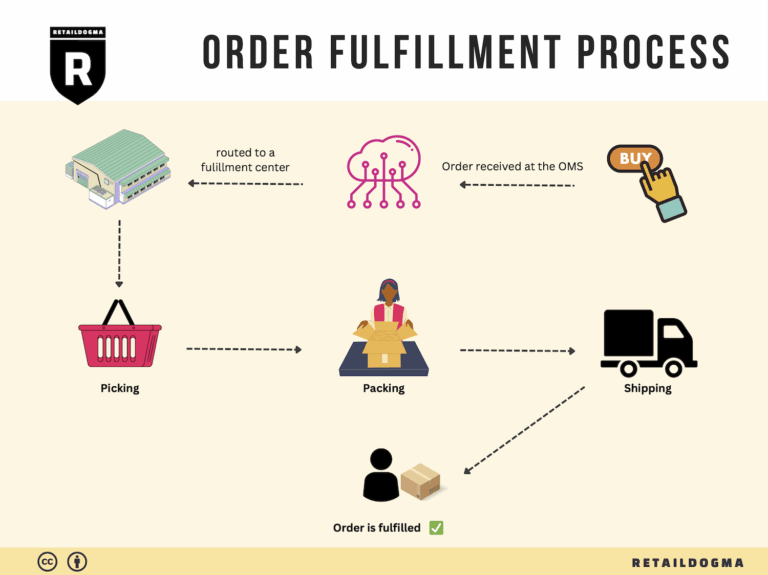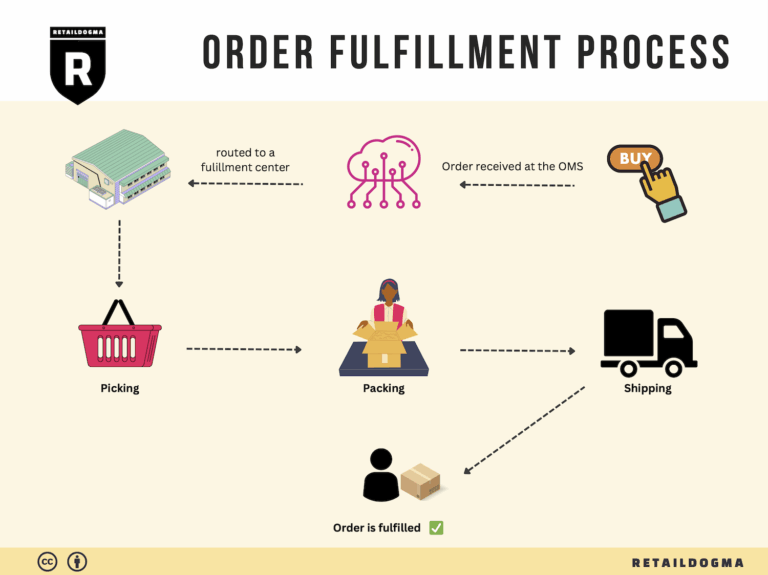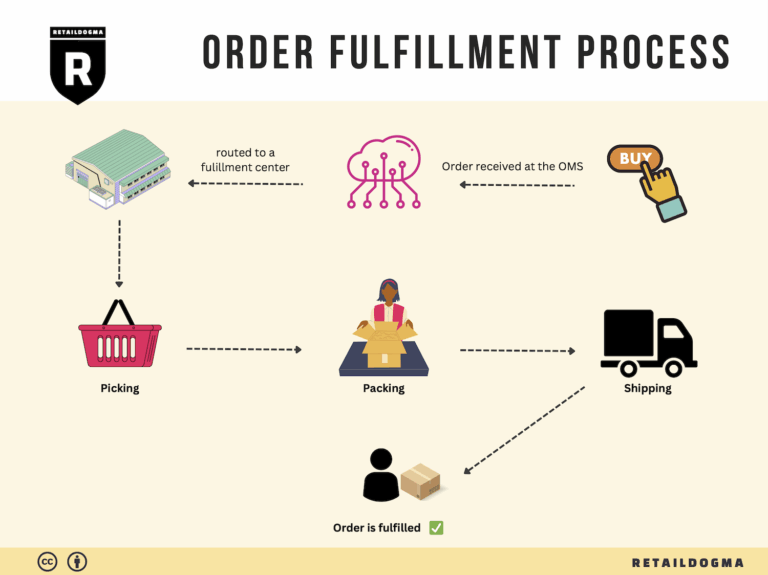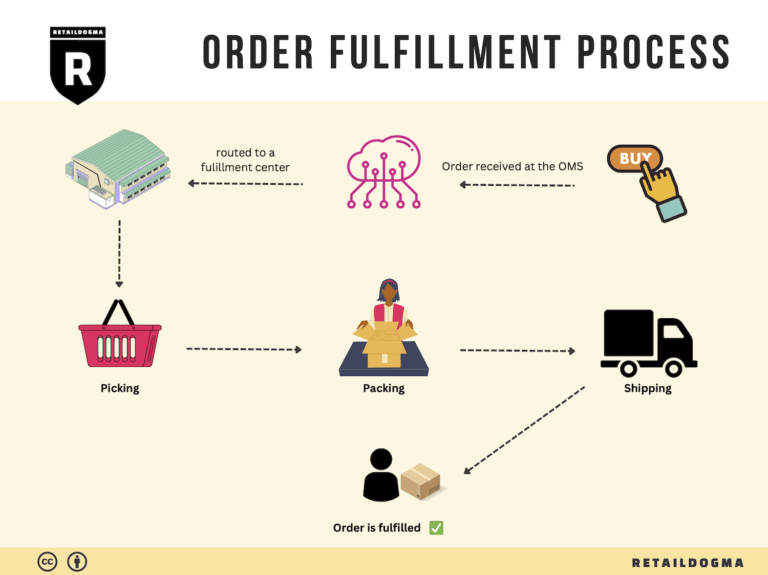What Is A Fulfillment Center? A Complete Guide (2025)
What is E-commerce Fulfillment? An Introduction for Growing Businesses
Understanding the Challenges of E-commerce Fulfillment
As a growing e-commerce business, you may find yourself drowning in the complexities of packing and shipping orders. The excitement of increasing sales can quickly turn into stress as you navigate the logistics of getting products to your customers. This overwhelming process often detracts from your core focus: growing your business and enhancing customer satisfaction.
E-commerce fulfillment is the backbone of your online operations, encompassing all activities required to get a product from your inventory into the hands of a customer. This includes picking, packing, shipping, and managing returns. Understanding the nuances of fulfillment is crucial for scaling your operations effectively.
The E-commerce Fulfillment Landscape
In this guide, we will explore various fulfillment models that can streamline your logistics process. You’ll learn about Fulfillment by Amazon (FBA) and Fulfillment by Merchant (FBM), each offering distinct advantages depending on your business needs. FBA allows you to leverage Amazon’s extensive logistics network, while FBM provides you with greater control over your fulfillment process.
We will also delve into core services that are essential for efficient fulfillment, such as inventory management, pick and pack, shipping, and warehousing. These services can significantly impact your operational efficiency and customer experience.
Choosing the Right Fulfillment Partner
Selecting the right fulfillment partner is a pivotal decision for your business. We will guide you through the key considerations to keep in mind when evaluating potential partners, including their technology capabilities, service offerings, and pricing structures. The right partner should align with your business goals and help you scale smoothly.
Understanding Pricing Models
Pricing can be one of the most confusing aspects of fulfillment. This guide will clarify the different pricing models you might encounter, ensuring you can make informed decisions that support your bottom line.

Empowering Your Logistics Decisions
Our goal is to empower you with the knowledge and tools necessary to make smart, strategic decisions about your logistics. By understanding the intricacies of e-commerce fulfillment, you can optimize your operations, enhance your customer experience, and ultimately drive growth in your business. Whether you are just starting out or looking to scale, this guide will serve as your comprehensive resource for navigating the world of e-commerce fulfillment.
What You’ll Learn In This Guide
- What is E-commerce Fulfillment? An Introduction for Growing Businesses
- The Order Fulfillment Process: From ‘Buy’ Button to Customer’s Door
- Comparing Fulfillment Models: In-House vs. 3PL vs. Dropshipping
- A Deep Dive into Amazon FBA: Pros, Cons, and Who It’s For
- Core Services Offered by Fulfillment Centers
- How to Choose a Fulfillment Partner: A 6-Point Checklist
- Understanding Fulfillment Pricing: A Breakdown of Common Fees
- Frequently Asked Questions (FAQs) about Fulfillment
- Conclusion: Is Outsourcing Fulfillment the Right Move for Your Business?
- Important Disclaimer
The Order Fulfillment Process: From ‘Buy’ Button to Customer’s Door
1. Receiving Inventory
The order fulfillment process begins with receiving inventory at the fulfillment center. When products arrive, they must be checked against purchase orders to ensure that the correct quantities and items have been delivered. This is a critical step that helps maintain accurate stock levels and prevents discrepancies.
Upon receiving, each product is assigned a Stock Keeping Unit (SKU), a unique identifier that simplifies inventory management. This identification allows for quick reference and tracking throughout the fulfillment process. Ensuring that every item is accurately logged into the system is essential for maintaining inventory accuracy, which directly impacts order fulfillment efficiency and customer satisfaction. Mismanaged inventory can lead to stockouts or overstock situations, both of which can harm sales and customer trust.
2. Warehouse Storage
Once inventory is received and logged, the next step is warehouse storage. Products are organized in designated areas based on various factors, such as size, type, and demand frequency. Efficient warehouse storage is vital because it directly influences the speed and accuracy of order fulfillment.
Using a Warehouse Management System (WMS), businesses can optimize storage locations. This software helps determine the best placement for each item, ensuring that high-demand products are easily accessible while slower-moving items are stored in less prominent areas. Properly organized storage not only maximizes space but also minimizes the time required for order picking, which is essential for meeting customer expectations for fast delivery.
3. Order Picking
Order picking is the process of retrieving products from storage to fulfill customer orders. This step is critical, as it directly impacts the accuracy of the order and the overall efficiency of the fulfillment process. Pick lists, which are generated based on customer orders, guide warehouse staff to the specific locations of the items needed.
Efficient order picking strategies, such as batch picking or zone picking, can significantly reduce the time taken to gather items. Batch picking involves collecting items for multiple orders simultaneously, while zone picking assigns workers to specific areas of the warehouse. Implementing effective picking strategies not only speeds up the fulfillment process but also reduces labor costs and errors, leading to a better customer experience.
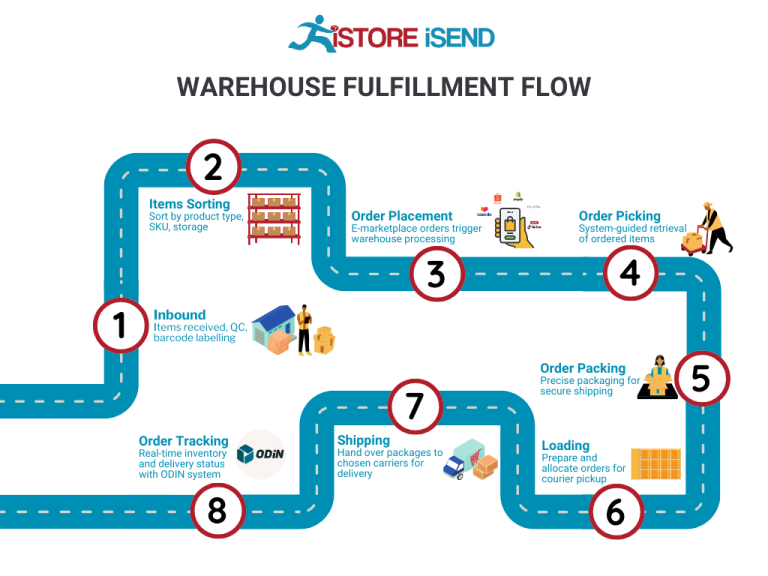
4. Order Packing
Once items have been picked, they proceed to the packing stage. This step involves securely packaging the products for shipment, which is crucial for preventing damage during transit. Quality control checks are typically performed at this stage to ensure that the correct items are packed and that they meet packaging standards.
Packaging materials, including boxes, bubble wrap, and tape, must be chosen carefully to ensure that products arrive in excellent condition. Businesses may also utilize packing slips that provide essential order details, enhancing transparency for both the fulfillment center and the customer. Proper packing can reduce return rates and increase customer satisfaction, making it an essential component of the order fulfillment process.
5. Shipping & Delivery
The final step in the order fulfillment process is shipping and delivery. Once orders are packed, they are labeled and prepared for shipment. This includes selecting the appropriate shipping method based on factors such as delivery speed, cost, and destination. Shipping logistics can be complex, especially for businesses that operate across various regions or countries.
Utilizing an effective logistics strategy, including partnerships with reliable carriers, ensures timely delivery to customers. Tracking systems play a crucial role at this stage, allowing both businesses and customers to monitor the shipment’s progress. Providing tracking information not only enhances customer satisfaction but also builds trust in the brand. Efficient shipping and delivery processes are essential for scaling operations, as they directly impact customer retention and repeat purchases.
In conclusion, each step of the order fulfillment process is interconnected and plays a vital role in ensuring that products are delivered efficiently and accurately from the moment a customer clicks the ‘buy’ button until the package arrives at their door. By optimizing each stage, businesses can enhance their operational efficiency, improve customer satisfaction, and ultimately drive growth.
Comparing Fulfillment Models: In-House vs. 3PL vs. Dropshipping
Fulfillment Model Comparison
| Model | Who Handles Inventory | Best For (Business Stage) | Key Advantage | Key Disadvantage |
|---|---|---|---|---|
| In-House Fulfillment | Business itself | Startups to Established | Full control over operations and branding | High overhead costs and resource demand |
| Third-Party Logistics (3PL) | 3PL provider | Established to Scaling | Scalable, reduces operational burden | Less control over fulfillment processes |
| Dropshipping | Supplier or dropshipper | Startups to Growth | Low upfront investment and risk | Lower profit margins and reliance on suppliers |
In-House Fulfillment
In-house fulfillment is a model where the e-commerce business manages all aspects of inventory and order processing within its own facilities. This approach provides complete control over the supply chain, allowing businesses to customize their fulfillment processes to align perfectly with their brand identity and customer expectations. For startups and established businesses with sufficient resources, in-house fulfillment can be advantageous due to the ability to ensure quality control, fast shipping, and personalized customer service.
However, this model comes with significant challenges. The overhead costs associated with maintaining a warehouse, hiring staff, and managing logistics can be substantial. Businesses must invest in technology for inventory management, order processing, and shipping, which can strain budgets, particularly for startups. Additionally, as order volumes grow, the demand on resources can escalate, leading to potential operational inefficiencies if not managed correctly.
Third-Party Logistics (3PL)
Third-party logistics (3PL) involves partnering with an external provider to manage inventory, warehousing, and fulfillment operations. This model is best suited for established businesses looking to scale or those with fluctuating order volumes. 3PL providers typically offer a range of services, including storage, order picking, packing, and shipping, which can significantly reduce the operational burden on the business.
The primary advantage of using a 3PL is scalability. As businesses grow, they can easily adjust their fulfillment capacity without the need for significant capital investment in infrastructure. Furthermore, 3PL providers often have access to advanced technology and logistics expertise, which can enhance operational efficiency and customer satisfaction. However, businesses may face challenges related to control and visibility. When outsourcing fulfillment, the business relies on the 3PL to maintain quality standards and timely deliveries, which can be a concern if the provider does not meet expectations.
Dropshipping
Dropshipping is a fulfillment model where the retailer does not keep products in stock. Instead, when a retailer sells a product, they purchase the item from a third-party supplier who ships it directly to the customer. This model is particularly appealing for startups and businesses in the growth phase due to its low upfront investment and minimal financial risk. Retailers can test new products and markets without the need for inventory management or warehousing.
The primary advantage of dropshipping is that it allows businesses to offer a wide range of products without the associated risks of holding inventory. This flexibility can lead to a diverse product offering and the ability to pivot quickly based on market demand. However, dropshipping also has its drawbacks. Profit margins are typically lower compared to other fulfillment models, as retailers rely on suppliers for pricing and shipping. Additionally, the retailer has little control over inventory levels, shipping times, and product quality, which can lead to customer dissatisfaction if suppliers fail to meet standards.
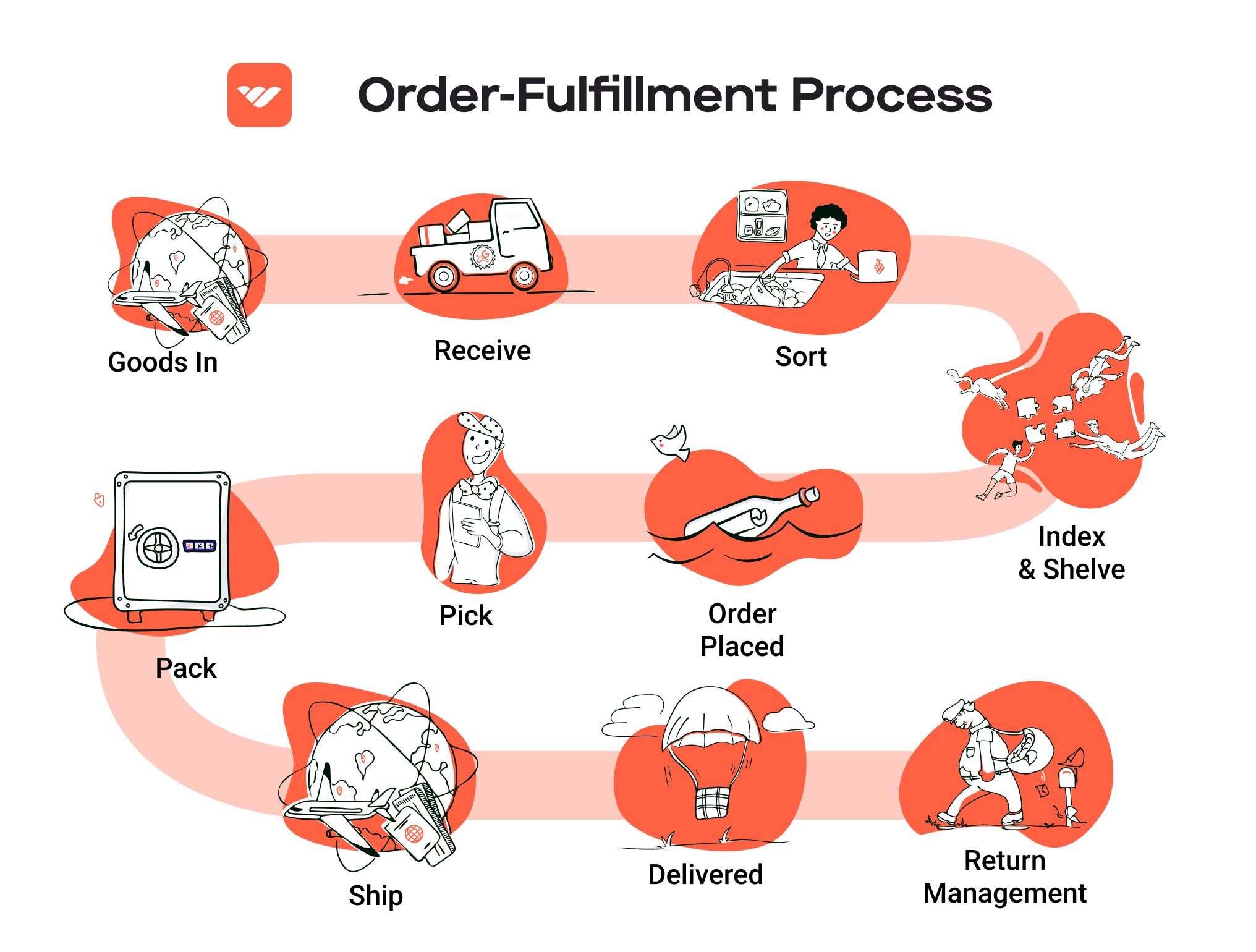
Conclusion
When choosing a fulfillment model, businesses must carefully consider their stage of growth, available resources, and long-term goals. Each model—whether in-house fulfillment, 3PL, or dropshipping—offers unique advantages and disadvantages that can significantly impact operational efficiency and customer satisfaction. Understanding these nuances will empower e-commerce business owners and operations managers to make informed decisions that align with their strategic objectives.
A Deep Dive into Amazon FBA: Pros, Cons, and Who It’s For
Understanding Fulfillment by Amazon (FBA)
Fulfillment by Amazon (FBA) is a service that allows e-commerce sellers to utilize Amazon’s extensive logistics network to store, pick, pack, and ship their products. Sellers send their inventory to Amazon’s fulfillment centers, where Amazon takes care of the entire fulfillment process. This includes not just shipping the products to customers, but also handling customer service and returns. This service has gained popularity among sellers due to Amazon’s established reputation and vast reach.
How FBA Works
-
Inventory Preparation: Sellers prepare their products according to Amazon’s guidelines, including packaging, labeling, and shipment requirements. Proper preparation is crucial to avoid delays and additional fees.
-
Shipping to Fulfillment Centers: Once the inventory is ready, sellers ship their products to designated Amazon fulfillment centers. Amazon provides specific addresses and guidelines to streamline this process.
-
Storage: Once received, Amazon stores the products in their warehouses until an order is placed. Sellers can monitor their inventory levels through their Amazon Seller Central account.
-
Order Fulfillment: When a customer places an order, Amazon takes care of picking, packing, and shipping the product. They use advanced technology and a highly efficient workforce to ensure timely delivery.
-
Customer Service: Amazon handles all customer service inquiries related to FBA orders, including returns and refunds, allowing sellers to focus on growing their business.
-
Multi-Channel Fulfillment: Sellers can also use FBA to fulfill orders from other sales channels, such as their own website or other marketplaces, further streamlining their operations.
Pros of Using FBA
1. Prime Eligibility
One of the most significant advantages of FBA is that products become eligible for Amazon Prime. This increases visibility and sales potential, as Prime members are more likely to purchase items that qualify for free two-day shipping.
2. Customer Trust
Products fulfilled by Amazon benefit from the trust associated with the Amazon brand. Customers feel more secure purchasing items that are backed by Amazon’s customer service and return policies, leading to higher conversion rates.
3. Multi-Channel Fulfillment
FBA allows sellers to fulfill orders from multiple sales channels using Amazon’s infrastructure. This versatility can simplify logistics and provide a more cohesive customer experience.
4. Scalability
FBA allows sellers to scale their operations without the need for extensive warehousing or logistics management. As sales grow, Amazon can handle increased order volumes seamlessly.
5. Time-Saving
By outsourcing fulfillment to Amazon, sellers can save significant time and resources. This frees them to focus on other critical aspects of their business, such as product development and marketing.
Cons of Using FBA
1. High Fees
FBA comes with various fees, including storage fees, fulfillment fees, and additional costs for long-term storage. These fees can add up, particularly for sellers with lower margins or slow-moving inventory.
2. Strict Inventory Rules
Amazon has stringent guidelines regarding inventory management, including labeling, packaging, and storage requirements. Failure to comply can result in additional fees or even removal of products from the platform.
3. Commingling Risks
FBA uses a commingling process, where products from different sellers may be stored together. This can lead to issues if a seller’s product is damaged or misrepresented, as returns and customer complaints could affect the seller’s account health.
4. Limited Control
By using FBA, sellers relinquish some control over their inventory and fulfillment processes. This can lead to challenges if there are discrepancies in inventory counts or fulfillment errors.
5. Dependency on Amazon
Sellers become reliant on Amazon’s policies, platform changes, and performance metrics. Any negative changes to Amazon’s algorithm or policies could significantly impact a seller’s business.
Who is FBA Best For?
FBA is particularly beneficial for:
-
Small to Medium-Sized Businesses: Companies without the infrastructure to handle logistics can leverage Amazon’s resources to compete effectively in the e-commerce space.
-
Sellers with High Sales Volume: Businesses that can maintain a high turnover of inventory will find FBA’s fees more manageable relative to their sales.
-
New Sellers: Entrepreneurs new to e-commerce can benefit from the established trust and logistics of Amazon, helping them to build their brand and customer base.
-
Sellers Looking to Scale: For businesses planning to expand quickly, FBA provides a scalable solution that allows them to grow without the headaches of managing fulfillment.
-
Those Focused on Customer Experience: Brands that prioritize customer satisfaction will appreciate Amazon’s customer service capabilities and return handling.
In summary, FBA offers a comprehensive solution for e-commerce sellers looking to streamline their operations and leverage Amazon’s vast network. While it comes with its own set of challenges, the benefits often outweigh the drawbacks for many businesses. By understanding how FBA works and evaluating whether it aligns with their business goals, sellers can make informed decisions about their fulfillment strategies.
Core Services Offered by Fulfillment Centers
Inventory Management & Warehousing
Inventory management and warehousing are foundational services provided by fulfillment centers that play a critical role in the supply chain of e-commerce businesses. Inventory management involves tracking and controlling stock levels, ensuring that the right amount of product is available to meet customer demand without overstocking or running into stockouts. This process typically utilizes advanced software systems that integrate seamlessly with e-commerce platforms, providing real-time data and insights.
The benefits of efficient inventory management are manifold. First, it helps businesses maintain optimal stock levels, reducing the costs associated with excess inventory and storage fees. Second, accurate inventory tracking minimizes the risk of overselling, which can lead to customer dissatisfaction and damage to brand reputation. Third, effective inventory management enhances forecasting accuracy, allowing businesses to make informed purchasing decisions and optimize their supply chain. By leveraging the warehousing capabilities of fulfillment centers, e-commerce businesses can store products closer to their customer base, significantly improving delivery times and reducing shipping costs.
Pick and Pack Services
Pick and pack services are essential components of order fulfillment that involve the selection (picking) of products from the warehouse and then packing them securely for shipment. This process is typically executed using specialized software that organizes orders and directs warehouse staff to the correct locations for each item. The packing phase ensures that products are safeguarded during transit, often including branded packaging options to enhance the customer experience.
The primary advantage of utilizing pick and pack services is the efficiency it brings to the order fulfillment process. By outsourcing these tasks to a fulfillment center, e-commerce businesses can scale their operations without the need to hire additional staff or invest in costly warehouse infrastructure. Furthermore, fulfillment centers often employ trained professionals who specialize in optimizing the pick and pack process, leading to faster order processing times and reduced errors. This efficiency not only speeds up delivery times but also improves overall customer satisfaction, a key driver in today’s competitive e-commerce landscape.
Kitting and Assembly
Kitting and assembly are value-added services that involve combining multiple products into a single package or kit before shipping. This can include anything from assembling a product that requires multiple components to creating subscription boxes filled with curated items. Kitting is particularly beneficial for e-commerce businesses that offer promotional bundles or seasonal products, allowing them to present a cohesive offering that appeals to customers.
The benefits of kitting and assembly services are twofold. Firstly, these services streamline the order fulfillment process by reducing the number of individual items that need to be picked and packed, thus saving time and labor costs. Secondly, kitting allows businesses to create unique product offerings that can differentiate them from competitors. By providing customers with curated kits or bundles, businesses can enhance the perceived value of their products, leading to increased sales and customer loyalty. Moreover, these services can be particularly effective for marketing campaigns or special promotions, as they enable businesses to present a compelling narrative around their products.
Returns Management (Reverse Logistics)
Returns management, or reverse logistics, refers to the process of handling returned products efficiently and effectively. This service encompasses everything from processing return requests and inspecting returned items to restocking or refurbishing products for resale. A streamlined returns management process is essential for e-commerce businesses, as the ease of returning products is a significant factor in customer satisfaction and repeat purchases.
The benefits of effective returns management are substantial. A well-structured returns process instills confidence in customers, knowing they can return items with minimal hassle. This can lead to higher conversion rates, as customers are more likely to make a purchase if they feel secure about the return policy. Additionally, fulfillment centers can help minimize losses associated with returns by assessing the condition of returned items and determining the best course of action—whether that be restocking, refurbishing, or recycling products. By efficiently managing returns, e-commerce businesses can recover value from returned goods and reduce the overall impact of returns on profitability.
By leveraging these core services offered by fulfillment centers, e-commerce businesses can scale their operations effectively, enhance customer satisfaction, and ultimately drive growth in a competitive marketplace.
How to Choose a Fulfillment Partner: A 6-Point Checklist
Location & Warehouse Network
Importance: The geographical location of your fulfillment partner’s warehouses can significantly impact shipping times, costs, and overall customer satisfaction. A strategically located fulfillment center can help reduce shipping times and costs, allowing you to offer competitive shipping options to your customers.
Questions to Ask:
– Where are your fulfillment centers located, and how does this align with my target customer base?
– What is your average shipping time to my primary markets?
– Do you have the capability to expand your network if my business grows or if I enter new markets?
Technology & Integrations
Importance: In today’s digital landscape, technology plays a crucial role in streamlining operations and ensuring seamless communication across platforms. A fulfillment partner with robust technology can automate processes, provide real-time inventory updates, and integrate with your existing e-commerce systems.
Questions to Ask:
– What technology platforms do you use for inventory management, order processing, and tracking?
– Can your systems integrate with my current e-commerce platform (e.g., Shopify, WooCommerce, Amazon)?
– Do you offer real-time tracking and reporting for inventory and shipments?
Specializations (e.g., Cold Storage, Oversized Items)
Importance: Depending on your product offerings, you may require specific fulfillment capabilities. If you sell perishable goods, for instance, you’ll need a partner that offers cold storage. Similarly, if your products are oversized or require special handling, ensuring your fulfillment partner has the right facilities and expertise is essential.
Questions to Ask:
– Do you have specialized facilities for handling specific types of products, such as food items or oversized goods?
– What procedures do you have in place for quality control and safety for specialized items?
– Can you accommodate unique packaging or labeling requirements for my products?
Scalability & Capacity
Importance: As your business grows, your fulfillment needs will change. Choosing a partner that can easily scale their services to accommodate your growth is crucial for maintaining efficiency and customer satisfaction.
Questions to Ask:
– What is your current capacity, and how quickly can you ramp up operations to meet increased demand?
– Do you have a plan in place for seasonal fluctuations in order volume?
– How do you handle inventory management during peak seasons?
Pricing and Contracts
Importance: Understanding the pricing structure and contract terms is vital to avoid unexpected costs and ensure your partnership remains profitable. A transparent pricing model can help you budget effectively and assess the overall value of the services offered.
Questions to Ask:
– What are your pricing models (e.g., per order, per item, storage fees)?
– Are there any additional costs I should be aware of, such as for returns or special handling?
– What are the terms of the contract, and is there flexibility in the agreement if my needs change?
Customer Support & Reviews
Importance: Strong customer support is essential for resolving issues quickly and efficiently. Additionally, researching reviews and testimonials can provide insight into the fulfillment partner’s reliability and quality of service.
Questions to Ask:
– What kind of customer support do you provide (e.g., dedicated account manager, 24/7 support)?
– Can you provide references or case studies from other clients in my industry?
– How do you handle issues related to order inaccuracies or shipping delays?
Conclusion
Choosing the right fulfillment partner is a critical decision that can impact your e-commerce business’s success. By using this checklist, you can systematically evaluate potential partners and ensure they meet your operational needs and growth plans. Prioritize open communication, thorough research, and a clear understanding of your business requirements to make an informed choice. A strong partnership with the right fulfillment provider can enhance your customer experience, streamline your operations, and ultimately contribute to your business’s growth.
Understanding Fulfillment Pricing: A Breakdown of Common Fees
Initial Setup Fees
Initial setup fees are typically charged when a business first begins using a fulfillment service. This fee can cover various aspects, including the integration of your e-commerce platform with the fulfillment center’s systems, setting up your inventory in their warehouse management system (WMS), and any necessary training for your team to navigate the new processes.
The calculation of initial setup fees can vary widely depending on the complexity of your operations. For instance, a straightforward setup may incur a minimal fee, while businesses requiring custom integrations or extensive training might face higher costs. It is essential to clarify what is included in the setup fee and any potential recurring charges associated with maintaining the integration.
Receiving Fees
Receiving fees are charged when your inventory arrives at the fulfillment center. These fees cover the labor involved in unloading, inspecting, and storing your products. The receiving fee can be calculated based on several factors, such as the volume of items being received, their weight, and whether any special handling is required.
For example, if you send a large shipment of bulky items, the receiving fee may be higher than for smaller, lighter products. Some fulfillment centers may also charge additional fees for discrepancies found during the inspection process, such as damaged goods or incorrect quantities. Therefore, it’s crucial to ensure that your shipments are accurate and in good condition to minimize these fees.
Storage Fees (per pallet/bin)
Storage fees are incurred for the space your inventory occupies within the fulfillment center. These fees are typically calculated on a per pallet or per bin basis and can vary based on the location and size of the warehouse. Many fulfillment centers charge monthly storage fees, which can be influenced by seasonal demand and your inventory turnover rate.
For instance, if you have slow-moving products that occupy space for an extended period, you may face higher storage costs. Conversely, faster-moving products will help you avoid excessive storage fees. Some fulfillment centers may also implement tiered pricing, where the fee per pallet decreases as you store larger quantities. Understanding your inventory dynamics is essential for managing storage costs effectively.
Pick & Pack Fees (per item/order)
Pick and pack fees are charged for the process of selecting items from inventory and packaging them for shipment. This fee can be calculated on a per-item or per-order basis, depending on the fulfillment center’s pricing structure. Typically, the more items in an order, the higher the pick and pack fee due to the increased labor and materials required.
For example, if your business often ships multi-item orders, you may want to negotiate a more favorable rate based on your order volume. Additionally, some fulfillment centers may offer discounts for high-volume orders or provide flat rates for specific services. Understanding the nuances of pick and pack fees can help you optimize your fulfillment strategy and reduce overall costs.
Shipping Fees
Shipping fees cover the costs associated with transporting your products to customers. These fees can vary based on the shipping method chosen (standard, expedited, etc.), the destination of the shipment, and the weight and dimensions of the packages. Many fulfillment centers have partnerships with shipping carriers, allowing them to offer discounted rates that can benefit your business.
It’s essential to evaluate the shipping options available and choose the most cost-effective method that meets your delivery time requirements. You may also want to consider offering multiple shipping options to customers at checkout, as this can enhance their shopping experience and potentially increase sales.
Conclusion: Tips for Getting an Accurate Quote
To obtain an accurate quote for fulfillment services, consider the following tips:
-
Provide Detailed Information: Share specific details about your products, order volume, and expected growth. The more information you provide, the more tailored the quote will be.
-
Understand Pricing Structures: Ask about each fee type and how they are calculated. This will help you identify potential hidden costs.
-
Inquire About Discounts: Many fulfillment centers offer discounts for higher volumes or long-term contracts. Don’t hesitate to negotiate.
-
Evaluate Additional Services: Consider any additional services you may require, such as kitting, labeling, or returns management, and how these will affect your overall costs.
-
Request a Trial Period: If possible, ask for a trial period to evaluate the fulfillment center’s services before committing to a long-term contract.
By following these tips, you can ensure that you receive a comprehensive and accurate quote that aligns with your business needs and budget.
Frequently Asked Questions (FAQs) about Fulfillment
1. How do I contact an Amazon Fulfillment Center?
To contact an Amazon Fulfillment Center, you typically need to reach out through your Seller Central account. Navigate to the “Help” section and use the “Contact Us” feature. You can also find specific contact information based on your region or fulfillment center by visiting Amazon’s official support pages.
2. What is the difference between Fulfillment by Amazon (FBA) and Fulfillment by Merchant (FBM)?
Fulfillment by Amazon (FBA) allows sellers to store their products in Amazon’s warehouses, where Amazon handles storage, packaging, shipping, and customer service. In contrast, Fulfillment by Merchant (FBM) means sellers manage their own inventory and shipping processes, retaining control over customer service and order fulfillment.
3. How can I find the location of Amazon Fulfillment Centers?
You can find Amazon Fulfillment Center locations by visiting Amazon’s official website or consulting third-party resources like logistics and e-commerce blogs that provide updated lists of FBA locations, including addresses and codes.
4. What is a 3PL?
A Third-Party Logistics provider (3PL) is a company that offers outsourced logistics services, including warehousing, inventory management, and order fulfillment. Businesses often partner with 3PLs to enhance their supply chain efficiency without investing heavily in infrastructure.
5. How much do fulfillment services cost?
Fulfillment service costs can vary widely based on factors such as order volume, storage needs, and additional services like kitting or returns management. Generally, costs may include storage fees (per cubic foot), pick and pack fees (per item), and shipping fees. It’s advisable to request quotes from multiple fulfillment centers to compare rates.
6. What services are typically offered by Amazon Fulfillment Centers?
Amazon Fulfillment Centers offer a range of services including inventory storage, order picking and packing, shipping, returns processing, and customer service. They also provide advanced technology solutions for inventory management and tracking.
7. How do I set up my products for FBA?
To set up your products for Fulfillment by Amazon, log in to your Seller Central account, navigate to “Inventory,” and select “Add a Product.” Follow the prompts to create listings, choose FBA as your fulfillment method, and prepare your products for shipment to the designated fulfillment center.
8. What is the process for handling returns with Amazon Fulfillment?
When a customer returns a product fulfilled by Amazon, the return is processed at the fulfillment center. Amazon manages the return logistics, inspecting the returned items and updating inventory levels accordingly. Sellers can view return information and manage customer interactions through their Seller Central account.
9. Can I switch from FBM to FBA or vice versa?
Yes, you can switch between Fulfillment by Amazon (FBA) and Fulfillment by Merchant (FBM). To switch to FBA, you will need to set up FBA for your products in Seller Central. If you want to switch to FBM, you can change the fulfillment method in your product listings. Be mindful of the implications this may have on your inventory management and customer service processes.
10. What are the benefits of using Amazon Fulfillment Centers for my business?
Utilizing Amazon Fulfillment Centers can provide several advantages, including access to Amazon’s vast logistics network, faster shipping options (such as Prime eligibility), reduced operational overhead, and the ability to scale your business without the need for significant investment in warehousing and fulfillment technology. This allows you to focus more on marketing and growing your business while Amazon handles the logistics.
Conclusion: Is Outsourcing Fulfillment the Right Move for Your Business?
Evaluating the Benefits of Outsourcing Fulfillment
In the rapidly evolving e-commerce landscape, outsourcing fulfillment can be a strategic move for businesses aiming to scale operations efficiently. The primary benefits of leveraging a fulfillment service include significant time savings, enhanced scalability, and access to specialized expertise.
By partnering with a fulfillment provider, businesses can offload the complexities of warehousing, order processing, and shipping logistics. This delegation allows e-commerce owners and managers to focus on core activities such as product development, marketing, and customer engagement. The time saved can be redirected toward strategic initiatives that drive growth and innovation.
Scalability is another critical advantage. Fulfillment services are designed to grow alongside your business, accommodating fluctuations in order volume without the need for substantial upfront investment in infrastructure. Whether you experience seasonal spikes or rapid growth, a capable fulfillment partner can adjust to meet demand seamlessly, ensuring that your customers receive their orders promptly.
Moreover, fulfillment providers bring valuable expertise to the table. With their advanced technology and logistics knowledge, they can optimize inventory management, improve order accuracy, and enhance overall customer satisfaction. This level of professionalism not only streamlines operations but can also create a competitive edge in the marketplace.
However, the success of outsourcing fulfillment heavily relies on selecting the right partner. It’s essential to evaluate potential fulfillment providers based on their capabilities, technology integration, and alignment with your business goals.
Take Action Today
To determine if outsourcing fulfillment is the right next step for your business, consider conducting an audit of your current shipping processes. Assess areas for improvement and identify whether a fulfillment service could enhance efficiency and customer satisfaction. As you embark on this journey, remember that the right partner can significantly influence your growth trajectory in the e-commerce space.
Important Disclaimer
⚠️ Important Disclaimer
The information in this guide is for educational purposes. Fulfillment services, pricing, and platform features change frequently. Always conduct your own due diligence and consult with providers directly before making business decisions.


